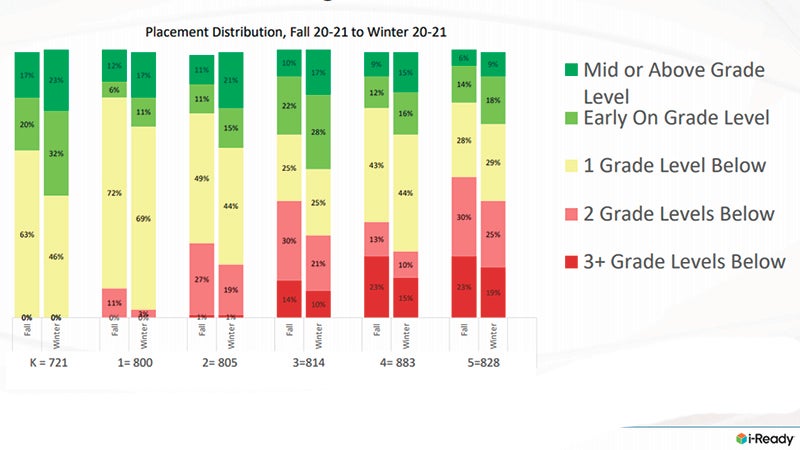School system gets mid-year update on math, reading scores
Published 9:30 am Saturday, March 20, 2021

- The above chart shows iReady reading assessment results by grade level for the fall and winter.
|
Getting your Trinity Audio player ready...
|
The Troup County School Board received an update from Assistant Superintendent Penny Johnson Thursday on how students are progressing in reading, math and other subjects during the school year.
Johnson’s presentation was based on mid-year reports from Reading Inventory and iReady. Students took an assessment to establish a starting point in August, and Johnson’s presentation compared a January assessment to the August numbers. Students will take another assessment in May at the end of the school year.
Based on the report data from both Reading Inventory and iReady, on average, elementary school students are experiencing gains in math and reading. However, most middle school students do not appear to be experiencing the same gains.
The Reading Inventory report shows students in second through eighth grade seeing their reading scores increase. For instance, in second grade, at the beginning of the year, 72 percent of students were below grade level in reading. That number is now 64 percent.
“I’m proud of our teachers and the work that they’re doing because for us to be experiencing positive gains during this time, it really supports the decisions that you all have made as far as being in school, being face to face, and meeting the needs of our students,” Johnson said to the school board.
The Reading Inventory numbers in the higher grades are not as promising, but Johnson noted “anomalies” in the data.
“When we get up into the higher grades, there are some anomalies like virtual learning and other things … we don’t have as much confidence in the data in the upper grades,” Johnson said.
iReady numbers show similar gains in elementary school. For example, in fourth grade mathematics, the number of students two grades below (27 percent in the fall) has fallen to 18 percent. The number of students either mid-on grade or early on grade has grown in first through fifth grade in both math and reading.
In middle school, the numbers are not showing the same kind of improvement. There have been some gains at the top of the spectrum, where students are on-grade or above, but students behind don’t appear to be catching up.
For instance, in seventh grade reading, 46 percent of students tested three grade levels or below in reading in the fall.
That number was 47 percent in the winter assessment, so it actually decreased.
The percentage of students three grades below or more in reading saw a 1 percent gain or decline in sixth, seventh and eighth grade, so there were no major gains.
“Middle School remains our biggest place where work needs to be done,” Johnson said.
She noted that a lot of the current curriculum has been purchased after students currently in middle school were out of elementary school.
“It was several years ago that we started adopting these systems that supported our students in the foundations of reading,” Johnson said.
“And what has happened is, as we’ve implemented the systems, you see that we’re experiencing progress.”
Board member Brandon Brooks asked what could be done to help middle school students who are behind.
“Everything we’re doing, these middle schoolers that are in that most risk right now, they’re really not getting the benefit of what we’ve implemented over the last couple years,” Brooks said.
Superintendent Brian Shumate said the school system is budgeting for additional support to the middle school curriculum.



